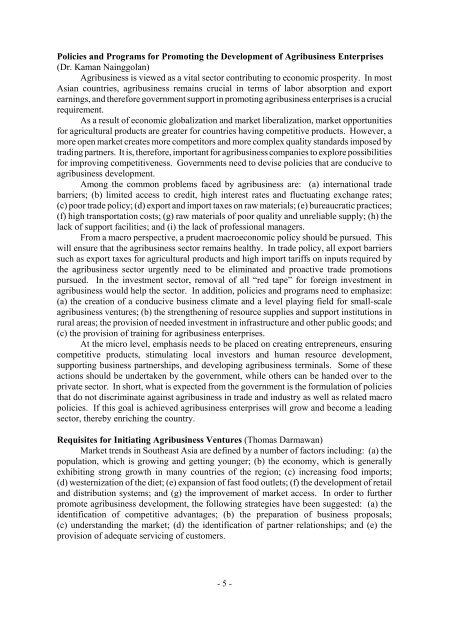Development of Agribusiness Enterprises - Asian Productivity ...
Development of Agribusiness Enterprises - Asian Productivity ...
Development of Agribusiness Enterprises - Asian Productivity ...
Create successful ePaper yourself
Turn your PDF publications into a flip-book with our unique Google optimized e-Paper software.
Policies and Programs for Promoting the <strong>Development</strong> <strong>of</strong> <strong>Agribusiness</strong> <strong>Enterprises</strong><br />
(Dr. Kaman Nainggolan)<br />
<strong>Agribusiness</strong> is viewed as a vital sector contributing to economic prosperity. In most<br />
<strong>Asian</strong> countries, agribusiness remains crucial in terms <strong>of</strong> labor absorption and export<br />
earnings, and therefore government support in promoting agribusiness enterprises is a crucial<br />
requirement.<br />
As a result <strong>of</strong> economic globalization and market liberalization, market opportunities<br />
for agricultural products are greater for countries having competitive products. However, a<br />
more open market creates more competitors and more complex quality standards imposed by<br />
trading partners. It is, therefore, important for agribusiness companies to explore possibilities<br />
for improving competitiveness. Governments need to devise policies that are conducive to<br />
agribusiness development.<br />
Among the common problems faced by agribusiness are: (a) international trade<br />
barriers; (b) limited access to credit, high interest rates and fluctuating exchange rates;<br />
(c) poor trade policy; (d) export and import taxes on raw materials; (e) bureaucratic practices;<br />
(f) high transportation costs; (g) raw materials <strong>of</strong> poor quality and unreliable supply; (h) the<br />
lack <strong>of</strong> support facilities; and (i) the lack <strong>of</strong> pr<strong>of</strong>essional managers.<br />
From a macro perspective, a prudent macroeconomic policy should be pursued. This<br />
will ensure that the agribusiness sector remains healthy. In trade policy, all export barriers<br />
such as export taxes for agricultural products and high import tariffs on inputs required by<br />
the agribusiness sector urgently need to be eliminated and proactive trade promotions<br />
pursued. In the investment sector, removal <strong>of</strong> all “red tape” for foreign investment in<br />
agribusiness would help the sector. In addition, policies and programs need to emphasize:<br />
(a) the creation <strong>of</strong> a conducive business climate and a level playing field for small-scale<br />
agribusiness ventures; (b) the strengthening <strong>of</strong> resource supplies and support institutions in<br />
rural areas; the provision <strong>of</strong> needed investment in infrastructure and other public goods; and<br />
(c) the provision <strong>of</strong> training for agribusiness enterprises.<br />
At the micro level, emphasis needs to be placed on creating entrepreneurs, ensuring<br />
competitive products, stimulating local investors and human resource development,<br />
supporting business partnerships, and developing agribusiness terminals. Some <strong>of</strong> these<br />
actions should be undertaken by the government, while others can be handed over to the<br />
private sector. In short, what is expected from the government is the formulation <strong>of</strong> policies<br />
that do not discriminate against agribusiness in trade and industry as well as related macro<br />
policies. If this goal is achieved agribusiness enterprises will grow and become a leading<br />
sector, thereby enriching the country.<br />
Requisites for Initiating <strong>Agribusiness</strong> Ventures (Thomas Darmawan)<br />
Market trends in Southeast Asia are defined by a number <strong>of</strong> factors including: (a) the<br />
population, which is growing and getting younger; (b) the economy, which is generally<br />
exhibiting strong growth in many countries <strong>of</strong> the region; (c) increasing food imports;<br />
(d) westernization <strong>of</strong> the diet; (e) expansion <strong>of</strong> fast food outlets; (f) the development <strong>of</strong> retail<br />
and distribution systems; and (g) the improvement <strong>of</strong> market access. In order to further<br />
promote agribusiness development, the following strategies have been suggested: (a) the<br />
identification <strong>of</strong> competitive advantages; (b) the preparation <strong>of</strong> business proposals;<br />
(c) understanding the market; (d) the identification <strong>of</strong> partner relationships; and (e) the<br />
provision <strong>of</strong> adequate servicing <strong>of</strong> customers.<br />
- 5 -
















